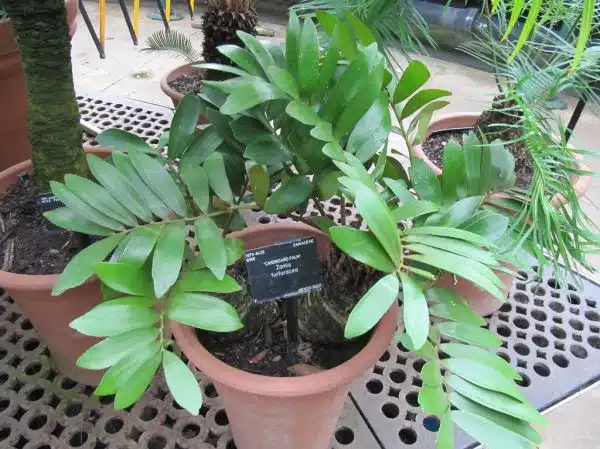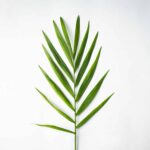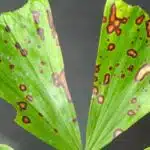The cardboard palm, also known as Zamia furfuracea, is a tropical plant native to Mexico. It is a member of the cycad family and is a popular houseplant due to its unique fronds and ease of care. This plant can grow up to 3 feet tall and wide, making it great for small spaces or as a statement piece in larger rooms.
To successfully grow and care for the cardboard palm, it is important to understand its specific needs. This includes providing it with proper light, soil, water, and temperature conditions. In this article, we will explore the various aspects of growing and caring for the cardboard palm, from selecting the right potting mix to fertilizing and repotting the plant. By following these tips and techniques, you can ensure that your cardboard palm thrives in your home or garden.
Understanding The Cardboard Palm Plant
Like a sturdy cardboard box, the Cardboard Palm plant (Zamia furfuracea) is an intriguing and exotic addition to any garden. The palm’s thick, leathery fronds resemble corrugated cardboard sheets, which is how it earned its unique name. This cycad species is native to eastern Mexico and thrives in warm, tropical climates.
The Cardboard Palm’s anatomy includes a thick stem that can grow up to 30 inches tall and 18 inches wide. Its fronds emerge from the top of the stem in a circular pattern, with each leaflet being ovular and pointed at the tip. The plant produces male and female cones separately, with the female cones bearing seeds that are toxic if ingested.
For gardeners looking to propagate their own Cardboard Palms, there are several techniques available. One method involves removing offsets or side shoots from the base of an existing plant and planting them in a suitable location. Another option is by seed propagation, where you can collect mature seeds from female cones in late summer or early autumn, sow them in moist soil mixtures or peat moss under bright light conditions until they germinate. With proper care and attention, your Cardboard Palm will flourish into a healthy specimen that adds distinctive character to your landscape design.
Transitioning into choosing the right location for your plant requires careful consideration of several factors such as light intensity, soil drainage capacity, temperature requirements among others that must be met for optimal growth of your Cardboard Palm.
Choosing The Right Location For Your Plant
- When selecting a location for a cardboard palm, it is important to consider its light exposure and soil drainage.
- Cardboard palms prefer bright, indirect sunlight and should not be exposed to direct, hot sunlight for extended periods of time.
- For optimal growth, the soil for a cardboard palm should be well-draining and slightly acidic.
- If possible, it is advisable to test the soil pH level to ensure it is between 5.5 and 6.5 before planting.
Light Exposure
For any plant enthusiast, finding the right location for your beloved green friend is of utmost importance. When it comes to the cardboard palm, light exposure plays a crucial role in determining its growth and overall health. To ensure optimal growth, it’s important to adjust light according to seasonal changes.
During the warmer months, the cardboard palm thrives in bright but indirect sunlight. Direct sunlight can cause leaf scorching and wilted foliage. It’s best to place the plant near a window that receives morning or afternoon sun but not both. In contrast, during winter months or when temperatures drop below 50°F (10°C), it’s best to move the plant indoors or in an area with little to no direct sunlight.
Adjusting light exposure based on seasonal changes helps maintain the cardboard palm’s health and longevity. A well-cared-for plant will produce healthy foliage and thrive for years to come. Remember, too much or too little light can hinder its growth and overall well-being. Finding that perfect spot may take some trial and error but is worth it in the end when you get to enjoy a beautiful green addition to your home or garden space.
Soil Drainage
Another crucial factor in choosing the right location for your plant is soil drainage. Plants like the cardboard palm require well-draining soil to prevent root rot and other water-related issues. Mulching techniques can help improve soil drainage by keeping the soil moist but not waterlogged. However, it’s essential to avoid over-mulching as it can lead to suffocation of roots.
In addition to mulching techniques, there are several drainage solutions available for plants that require well-draining soil. For instance, adding a layer of gravel or sand at the bottom of the pot can help water flow freely through the soil without accumulating at the bottom. Additionally, drilling holes at the bottom of containers or using pots with built-in drainage holes can also aid in proper soil drainage.
Properly draining soil is critical for maintaining optimal plant health and preventing water-related issues. Choosing suitable mulching techniques and implementing proper drainage solutions are necessary steps when selecting a spot for your cardboard palm or any other plant. By following these guidelines, you can help ensure your plants thrive and add natural beauty to your indoor or outdoor space.
Selecting The Ideal Potting Mix
Once you have found the ideal location for your cardboard palm plant, it is time to move on to selecting the appropriate potting mix. This step is crucial in ensuring that your plant receives the necessary nutrients and support for optimal growth. There are various potting mix options available in the market, but not all of them are suitable for your plant’s needs.
When selecting a potting mix, make sure to choose one that has good drainage and aeration properties. A well-draining mix prevents waterlogging and root rot, while good aeration allows roots to breathe and absorb nutrients effectively. Potting mixes with ingredients such as perlite, vermiculite, or sand help improve drainage and aeration. Additionally, choosing a mix with added organic matter like peat moss or compost can provide essential nutrients to the plant.
Other potting mix ingredients to consider include coconut coir and bark chips. Coconut coir is an eco-friendly alternative to peat moss that retains moisture well while still allowing for adequate drainage. Bark chips also provide good drainage while adding texture to the soil. When mixing your own potting soil, it’s best to combine different ingredients in appropriate proportions based on their characteristics.
In selecting the right potting mix for your cardboard palm plant, ensure that it provides a balanced ratio of water retention and drainage capacity while also supplying essential nutrients. You may opt for commercial mixes or create one yourself by blending several ingredients together in specific amounts. With these guidelines in mind, you’ll be able to provide your plant with an environment conducive to healthy growth and development. Next up is watering your cardboard palm plant effectively without over or under-watering it.
Watering Your Cardboard Palm Plant
The cardboard palm plant is known for its ability to survive in low-water conditions, making it an ideal choice for those who tend to forget about watering their plants. However, the plant still needs a certain level of moisture to thrive. Watering frequency will vary depending on the climate and environment in which your plant is situated. Generally, it’s best to water your cardboard palm once a week during the growing season and less frequently during the dormant season.
It’s crucial to ensure that you don’t overwater your cardboard palm as this can lead to root rot and other issues that could harm the plant. Signs of overwatering include yellowing leaves or leaves falling off, wilting, and mushy or smelly soil. If you notice any of these symptoms, reduce your watering frequency and check if there’s proper drainage in your pot.
Watering frequency aside, providing proper drainage is also essential for ensuring the health of your cardboard palm plant. Without adequate drainage, excess water can accumulate at the bottom of the pot and cause root rot. To prevent this from happening, make sure that there are enough drainage holes in your pot and use a well-draining soil mix. You may also consider adding some gravel or sand at the bottom of the pot to help with drainage. With proper watering techniques and drainage provision, you can keep your cardboard palm healthy and strong for years to come!
Next section topic: Providing Proper Drainage
Providing Proper Drainage
Cardboard palm (Zamia furfuracea) is a drought-tolerant plant, and should be watered sparingly with no more than one inch of water per week. To ensure proper drainage, it is important to use a well-draining soil when planting the cardboard palm. Additionally, it is recommended to use pots with drainage holes, as this will prevent the plant from becoming waterlogged. When it comes to drainage, it is important to note that cardboard palm prefers a slightly acidic soil with a pH of approximately 5.5-6.0. Furthermore, when re-potting, it is important to use a pot with a drainage hole, which will reduce the risk of root rot. Finally, when fertilizing, apply a balanced fertilizer at half strength every four to six weeks during the growing season.
Watering Sparingly
Cardboard palm, also known as Zamia furfuracea, is a popular houseplant among garden enthusiasts due to its striking appearance and ease of care. When it comes to providing proper drainage for cardboard palm, watering sparingly is crucial. Overwatering can lead to root rot and ultimately kill the plant. Therefore, using a moisture meter to determine the soil’s moisture level is essential for maintaining the right amount of water.
Creating a watering schedule is another effective way of ensuring proper drainage for your cardboard palm. Depending on the humidity levels in your area, you may need to water your plant once or twice a month. However, it’s important to keep in mind that overwatering can be just as harmful as underwatering. Therefore, checking the moisture level of the soil regularly and adjusting the watering schedule accordingly is crucial for keeping your cardboard palm healthy.
In conclusion, maintaining proper drainage for your cardboard palm requires careful attention to its watering needs. Using a moisture meter and creating a watering schedule are two simple yet effective ways of achieving this goal. By following these tips, you can ensure that your cardboard palm thrives and continues to add beauty to your home or garden for years to come.
Using Well-Draining Soil
Providing proper drainage is essential in keeping your cardboard palm healthy and thriving. One of the ways to achieve this is by using well-draining soil, as it allows excess water to drain away from the roots and prevents waterlogging. Using organic fertilizers can also help improve the quality of the soil and provide essential nutrients for your plant’s growth.
When choosing a container size for your cardboard palm, it’s important to consider its size and growth rate. The container should be large enough to accommodate the plant’s root system and allow room for growth. A too-small container may result in root-bound plants, which can stunt their growth and cause other problems.
In summary, providing proper drainage for your cardboard palm requires careful consideration of various factors such as soil quality, watering needs, and container size. Using well-draining soil can prevent waterlogging, while choosing the right container size can encourage healthy root development. Additionally, incorporating organic fertilizers into your care routine can help improve soil quality and provide essential nutrients for your plant’s growth.
Using Pots With Drainage Holes
Proper drainage is an essential factor in ensuring the health and longevity of a cardboard palm. One effective method for achieving this is by using pots with drainage holes. These holes allow excess water to drain away from the soil, preventing waterlogging and root rot.
When using pots with drainage holes, it’s important to consider the watering frequency of your cardboard palm. Watering too frequently can result in overwatering, which can become a problem if the pot doesn’t have proper drainage. The presence of drainage holes ensures that excess water is removed from the soil, reducing the risk of overwatering and its negative effects on plant health.
Using pots with drainage holes also helps improve soil drainage. When water is allowed to drain freely from the bottom of the pot, it carries away any excess salt or minerals that may have built up in the soil. This prevents salt buildup and allows for better absorption of nutrients by the roots, promoting healthy growth for your cardboard palm.
Fertilizing Your Cardboard Palm Plant
To ensure that your cardboard palm plant thrives, it is essential to fertilize it regularly. The best fertilizer for this plant is a slow-release, balanced fertilizer that contains equal amounts of nitrogen, phosphorus, and potassium. This type of fertilizer will provide your plant with the necessary nutrients to grow strong and healthy.
When it comes to fertilizing your cardboard palm plant, you should follow a regular schedule. During the growing season, which typically lasts from spring to summer, you should fertilize your plant every two weeks. During the dormant season in fall and winter, reduce the frequency of fertilization to once every month or two. Over-fertilizing can lead to burnt leaves and damage to the root system.
Remember to always water your plant thoroughly after applying fertilizer. This will help distribute the nutrients evenly throughout the soil and prevent any burning or damage caused by excessive fertilizer salts. By following a proper fertilizing schedule and using the best fertilizer for your cardboard palm plant, you can ensure that it will thrive for years to come.
As important as fertilizing is pruning your plant for optimal growth. Regular pruning helps remove dead or damaged fronds and promotes new growth. In the next section, we will discuss how to prune your cardboard palm plant correctly for maximum benefits.
Pruning Your Plant For Optimal Growth
After fertilizing your cardboard palm plant, it’s important to give it the proper pruning techniques for growth optimization. Pruning is a process of removing dead or damaged leaves and stems. It also helps to shape the plant and keep it healthy. Cardboard palms grow slowly, so pruning should be done carefully and only when necessary.
To prune your cardboard palm plant, you’ll need a pair of sharp pruners or garden shears. Start by cutting off any yellow or brown leaves at the base of the stem. These leaves are no longer contributing to the health of the plant and can attract pests. Be careful not to cut too close to the stem as this can cause damage.
Next, look for any branches that are growing in an awkward direction or crossing over each other. Cut these branches off at their base to encourage new growth in a more desirable direction. You can also remove any dead or diseased stems as they will not contribute to healthy growth. Keep in mind that cardboard palms are slow-growing plants, so do not over-prune them as it may stunt their growth.
In order to maintain optimal growth for your cardboard palm plant, regular pruning is essential. With proper care and attention, your plant will thrive and add beauty to your indoor or outdoor space. In the next section, we will discuss repotting your cardboard palm plant for even better growth results.
Repotting Your Cardboard Palm Plant
As your cardboard palm plant grows, it will eventually outgrow its current pot and require repotting. Repotting frequency varies depending on the plant’s growth rate and the size of the current pot. However, as a general rule, cardboard palms should be repotted every two to three years. This allows sufficient space for growth and prevents root crowding.
Repotting techniques vary widely depending on the size of the plant and the pot. Small plants can be carefully removed from their pots and placed into larger ones with fresh soil. Larger plants may require more extensive preparation, such as trimming roots that have become too long or thick. It is important to use well-draining soil during repotting to prevent root rot.
In conclusion, regular repotting is essential for maintaining the health of your cardboard palm plant. Repot every two to three years, using appropriate techniques based on the size of your plant and its current pot. Next, we will explore propagating your plant for more growth by discussing cutting techniques.
Propagating Your Plant For More Growth
After successfully repotting your cardboard palm plant, it’s time to think about propagating your plant for more growth. Propagation techniques usually involve taking a cutting from the mother plant and growing it into a separate, new plant. Cardboard palms can be propagated through seeds or division of the root ball.
When propagating using seeds, soak them in water for 24-48 hours before planting them in a well-draining potting mix. Keep the soil moist but not wet, and place the pot in indirect sunlight. Germination may take up to several months. When dividing the root ball, carefully remove the plant from its container and gently separate the roots with your hands or a knife. Plant each new section in its own pot with fresh soil.
Soil preparation is crucial when propagating or caring for cardboard palm plants. The soil should be well-draining and sandy, as these plants are susceptible to root rot if over-watered or planted in heavy soil. A mixture of sand and peat moss works well as a potting mix. Fertilize every two months during growing season with a slow-release fertilizer specifically formulated for palms.
Moving on from propagation techniques and soil preparation, it’s important to note that cardboard palms are generally low maintenance plants. However, they can still fall prey to common pests such as spider mites or mealybugs, as well as fungal diseases like leaf spot or root rot. In the next section, we will discuss how to identify these pests and diseases and provide tips on how to deal with them effectively without harming your plant.
Dealing With Common Pests And Diseases
Identifying symptoms of pests and diseases in cardboard palms is essential for maintaining their health. One common pest that affects this plant is the spider mite, which causes yellow spots on its leaves. Another pest that attacks the cardboard palm is the mealybug, which appears as white cottony masses on its leaves and stems. In addition, root rot caused by overwatering can also affect the plant’s overall health.
When it comes to dealing with pests and diseases in cardboard palms, natural remedies are an effective solution. For instance, neem oil is a natural insecticide that helps eliminate spider mites and mealybugs. Another natural remedy is a mixture of water and dish soap, which can be used to control aphids and other soft-bodied insects. Additionally, treating root rot involves reducing watering frequency and improving drainage.
Incorporating natural remedies into your gardening routine not only protects the environment but also promotes a healthier soil ecosystem. Identifying symptoms of pests and diseases in your cardboard palm early on can help prevent further damage to your plant. With proper care and maintenance, you can keep your cardboard palm healthy and thriving for years to come. In the subsequent section, we will discuss how to prevent pest infestations from occurring in the first place.
Preventing Pest Infestations
- Inspecting plants regularly is an important step in preventing pest infestations in cardboard palms.
- Whenever possible, remove any infested fragments of the plant as soon as they are discovered.
- Insecticides and pesticides can be used to effectively control pest infestations in cardboard palms.
- However, it is important to ensure that the correct product is used, as many insecticides are not safe for use on edible plants.
- It is also important to follow the manufacturer’s instructions when using insecticides and pesticides, to ensure that the product is used in a safe and effective manner.
- If the infestation is severe, it may be necessary to remove the entire plant in order to prevent it from spreading to other plants.
Inspect Plants Regularly
Regular inspection of plants is a crucial aspect of pest prevention in gardening. As a horticulturalist, it is essential to keep a close eye on the cardboard palm to avoid any pest infestations. Inspecting the plant regularly will help identify any issues before they become severe and unmanageable.
Pest prevention begins with regular inspections. Gardeners need to check for any signs of insects or diseases that may affect the health of the plant. For instance, aphids are common pests that attack cardboard palms, causing wilting and yellowing leaves. Regular inspection can help detect these pests early enough before they cause significant damage to the plant.
Inspecting plants is not only important for pest prevention but also helps keep the garden healthy and productive. When inspecting the cardboard palm, one should look for any signs of nutrient deficiency or over-fertilization which can lead to stunted growth or leaf burn respectively. By routinely checking on the plant’s health status, gardeners can take appropriate action to remedy any issues that may arise and ensure continued growth and productivity.
In conclusion, regular inspection is crucial in preventing pest infestations in cardboard palms as well as maintaining overall plant health. A horticulturalist should make it a habit to examine their plants frequently to identify any issues early enough before they escalate into severe problems. This practice not only ensures the longevity of cardboard palms but also guarantees a healthy and vibrant garden for all gardening enthusiasts out there!
Remove Infested Fragments
Identifying infestation signs is crucial in preventing pest infestations in gardening. Gardeners should regularly inspect their plants for any signs of pests like webs, holes, and uneven coloring. Once identified, it is essential to take immediate action to prevent the pests from spreading to other plants. One effective method is removing infested fragments.
Removing infested fragments is a natural pest control method that involves cutting off and disposing of any parts of the plant that show signs of pest damage or disease. This method helps prevent the spread of pests and diseases to other healthy parts of the plant or other nearby plants. Infested fragments can be disposed of by burning, burying deep into the soil, or sealing them in a plastic bag before disposal.
In conclusion, identifying infestation signs and removing infested fragments are crucial steps in preventing pest infestations naturally. Gardeners should make it a habit to inspect their plants regularly and take appropriate action once they notice any signs of pests or diseases. By doing this, they can maintain a healthy garden that will provide an excellent outdoor space for relaxation and enjoyment.
Use Insecticides/Pesticides
In addition to identifying infestation signs and removing infested fragments, using insecticides/pesticides is another way to prevent pest infestations in gardening. However, it is crucial to use them safely and responsibly to avoid harming beneficial insects, animals, and humans. Gardeners must follow the instructions carefully and wear protective gear when handling chemical insecticides/pesticides. They should also opt for natural alternatives whenever possible.
Natural alternatives to chemical insecticides/pesticides include using companion planting, biological controls like introducing natural predators of pests, and organic pesticides made from natural ingredients such as neem oil or garlic spray. These methods are safe and effective in controlling pests without causing harm to the environment or beneficial insects.
In conclusion, preventing pest infestations in gardening can be achieved through a combination of identifying infestation signs, removing infested fragments, and using insecticides/pesticides safely or opting for natural alternatives. Gardeners must prioritize environmentally friendly methods that are safe for themselves, their plants, and other living organisms that share the garden space.
Avoiding Overwatering And Underwatering
Cardboard palms require a balance of moisture to thrive. Overwatering can cause the roots to rot, while underwatering can lead to stunted growth and yellowing leaves. Signs of overwatering include yellow or brown leaves, wilting or drooping foliage, and a soggy potting mix. On the other hand, signs of underwatering include dry soil, curled or crispy leaves, and slow growth.
To avoid overwatering your cardboard palm, ensure that you allow the top inch of soil to dry out before watering again. Additionally, make sure that your plant is potted in well-draining soil to prevent water from accumulating around the roots. Always check for drainage holes at the bottom of your pot to prevent waterlogging.
To detect when your cardboard palm is underwatered, stick your finger into the soil up to an inch deep. If it feels dry at this depth, it’s time to water your plant. Another tip is to lift the container and gauge its weight – if it feels light, then it needs watering. However, avoid letting the entire root ball dry out completely as this can lead to shock and damage the plant’s health.
When managing temperature and humidity for cardboard palms, there are several factors to consider in addition to proper watering techniques. These factors include finding a suitable location with adequate sunlight exposure and monitoring indoor temperatures during winter months.
Managing Temperature And Humidity
Cardboard palm plants prefer temperatures between 65-75°F, and may become stressed in temperatures below 50°F or above 80°F.
Humidity should be kept at or above 40% to ensure a healthy plant, and a humidity tray or humidifier can be used to maintain this level.
To maintain heat, plants should be placed in warm, draft-free areas and away from any air vents or radiators.
Regular misting of the leaves can also help keep the air around the plant humid, as well as providing a much-needed source of water.
Maintaining Heat
One of the most important factors in growing and caring for cardboard palm is managing temperature and humidity. While it is a hardy plant that can survive in various conditions, maintaining heat during colder months can be challenging. Using grow lights is an effective way to ensure that the plant gets enough warmth and light during winter.
Humidity trays are another useful tool in maintaining heat for cardboard palm plants. These trays provide a stable environment with consistent moisture levels, which is essential for the plant’s growth and health. Simply fill a tray with pebbles or gravel and add water until it reaches just below the surface. Place the pot on top of the pebbles, making sure it does not touch the water directly.
In addition to using grow lights and humidity trays, there are other winter care tips for cardboard palm plants. Avoid placing them near drafty windows or doors as cold air can damage their leaves. Regularly misting them with water also helps maintain humidity levels around the plant. By following these simple steps, you can ensure that your cardboard palm thrives even in colder months.
Controlling Humidity
Managing temperature and humidity is crucial in caring for cardboard palm plants, as it helps ensure their health and growth. In addition to using grow lights and humidity trays, controlling humidity is another important factor to consider. High humidity levels can cause mold and fungal growth, which can harm the plant’s leaves and roots. On the other hand, low humidity can lead to dryness and wilting of the plant.
One way to control humidity is by using a dehumidifier. This device helps reduce excess moisture in the air by removing water vapor, thus preventing mold growth and maintaining a healthy environment for the plant. Another effective technique is air circulation, which involves ensuring that there is proper ventilation around the plant. This can be achieved by opening windows or doors or using a fan to create airflow. Proper air circulation also helps prevent stagnant air that can encourage mold growth.
In conclusion, managing humidity is an essential aspect of caring for cardboard palm plants. By using dehumidifiers and implementing air circulation techniques, gardeners can maintain ideal moisture levels for their plants’ optimal growth and health. With these simple tips, cardboard palms can thrive all year round, even in changing weather conditions.
Understanding The Growth Cycle Of The Cardboard Palm Plant
Understanding the growth patterns of the cardboard palm plant is essential for its proper care and maintenance. These plants grow slowly, but they can reach up to 10 feet in height over time. They are also known for their unique cardboard-like texture, which makes them an excellent addition to any garden or indoor space.
To ensure that your cardboard palm plant grows healthily, it is crucial to maintain healthy foliage throughout its growth cycle. One way to achieve this is by ensuring that the plant receives sufficient sunlight and water. Cardboard palm plants thrive in a warm and humid environment, so it is recommended to keep them at temperatures between 60°F-85°F with humidity levels around 50%.
Proper care and maintenance can prevent common issues with your cardboard palm plant. However, some problems may still arise, such as yellowing leaves, brown tips, or root rot. Troubleshooting these issues requires careful observation of the plant’s condition and taking necessary corrective measures promptly. In the next section, we will discuss how to diagnose and treat common problems that may arise when caring for your cardboard palm plant.
Troubleshooting Common Issues With Your Cardboard Palm Plant
Identifying symptoms of diseases and pests is an essential step in maintaining the health of your cardboard palm plant. One common symptom is yellowing or browning of the leaves. This can be caused by overwatering, underwatering, or nutrient deficiencies. It is important to monitor the soil moisture levels and adjust watering frequency accordingly. Additionally, fertilizing with a balanced fertilizer every few months can help provide the necessary nutrients for healthy growth.
Another common issue faced by cardboard palm plants is pests such as spider mites or mealybugs. These pests can cause leaf discoloration, stunted growth, and even death if not treated promptly. To control these pests, it is recommended to use natural insecticides such as neem oil or insecticidal soap. Applying these treatments regularly can help prevent pest infestations from occurring.
In summary, identifying symptoms of diseases and pests early on can prevent further damage to your cardboard palm plant. Take preventative measures such as monitoring soil moisture levels and fertilizing regularly to promote healthy growth. If pest infestations occur, using natural insecticides can effectively control them without causing harm to your plant or the environment. By taking care of your cardboard palm plant properly, you will be rewarded with a beautiful and healthy addition to your garden or home decor.
Frequently Asked Questions
How Long Does It Take For A Cardboard Palm To Reach Maturity?
The cardboard palm, also known as Zamia furfuracea, is a slow-growing plant that can add a touch of exoticism to any garden or home. As a member of the cycad family, its leaves resemble those of a fern and its trunk resembles that of a palm tree. The cardboard palm can take up to ten years to reach maturity and grow up to 3-4 feet tall. It is important to note that the growth rate depends on various factors such as growing conditions and pruning techniques. The cardboard palm thrives in well-draining soil with partial shade or bright indirect light. It is advisable to prune it only when necessary, removing dead or damaged fronds to promote growth. Overall, the cardboard palm requires minimal maintenance but yields maximum visual appeal for those who appreciate its unique appearance.
Can A Cardboard Palm Be Grown Indoors?
Cardboard palms are native to the tropical regions of Mexico and Central America. These plants can be grown indoors as long as certain conditions are met. Adequate sunlight, proper drainage, and a humid environment are necessary for the plant’s growth and survival. Regular watering and fertilization are also essential maintenance requirements for cardboard palms grown indoors. It is important to note that indoor conditions may not provide enough space for the plant to reach its full potential size. However, with proper care, cardboard palms can add a touch of tropical elegance to your home or office space.
Is The Cardboard Palm Plant Toxic To Pets Or Children?
As a horticulturalist or gardening specialist, it is essential to consider the safety of pets and children when selecting plants for your garden. The cardboard palm plant, also known as Zamia furfuracea, contains toxins that can be harmful to animals and humans if ingested. Therefore, it is important to explore safe alternatives and opt for pet-friendly gardening. Some options include spider plants, Boston ferns, and African violets. By prioritizing the well-being of our furry friends and little ones, we can create a beautiful and healthy garden that everyone can enjoy.
Can A Cardboard Palm Be Grown From Seed?
The germination process for cardboard palm seeds can be a bit challenging, as the seeds require specific optimal growing conditions. It is recommended to soak the seeds in warm water for 24 hours before planting them in a well-draining soil mix. The ideal temperature range for germination is between 80-90°F and it may take up to two months for the seedlings to emerge. Once germinated, cardboard palms grow best in full sun or partial shade with regular watering and fertilization during the growing season. It should be noted that cardboard palms are slow-growing plants, taking several years to reach maturity. Patience and proper care are essential when growing this unique plant from seed.
How Often Should A Cardboard Palm Be Fertilized?
Just like any other plant, cardboard palms require a balanced supply of nutrients for optimal growth. To achieve this, it is vital to follow a fertilizer schedule that meets the nutrient requirements of the plant. Typically, cardboard palms should be fertilized 3-4 times annually with a slow-release fertilizer that contains equal parts nitrogen, phosphorus, and potassium. However, it is important to note that over-fertilization can cause harm to the plant’s roots and leaves. As such, it is best to use a balanced fertilizer sparingly and monitor the plant’s response regularly. By adhering to an appropriate fertilizer schedule, gardening enthusiasts can ensure that their cardboard palm thrives without compromising its health.
Conclusion
The cardboard palm, also known as Zamia furfuracea, is a slow-growing and drought-tolerant plant native to Mexico. It typically takes around 10 years to reach maturity and can grow up to 6 feet tall in the right conditions. While it prefers warm temperatures and bright sunlight, it can also be grown indoors with proper care.
One important thing to keep in mind when growing a cardboard palm is that all parts of the plant are toxic if ingested by pets or children. Therefore, it’s important to keep it out of reach or choose an alternate plant if you have young ones or furry friends in your home.
To propagate a new cardboard palm, you can collect its orange fruit and remove the fleshy outer layer before planting the seeds. When it comes to fertilizing, it’s recommended to use a slow-release fertilizer once in spring and again in summer.
In conclusion, for those looking for a unique and low-maintenance addition to their garden or indoor space, the cardboard palm may be just what you need. However, remember that patience is key as this plant grows slowly but surely over time. As they say, “Rome wasn’t built in a day” – so too must we nurture our plants with care and patience for them to flourish.
Image Credits
- “Zamia furfuracea (Cardboard Palm)” by wallygrom (featured)





























